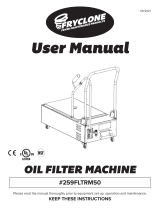
iv
1814E with FilterQuick
™
Series Electric Fryers
Installation and Operation Manual
TABLE OF CONTENTS
CHAPTER 1: Introduction
1.1 General ..................................................................................................................................... 1-1
1.2 Safety Information ................................................................................................................... 1-1
1.3 Controller Information ............................................................................................................. 1-2
1.4 European Community (CE) Specific Information ................................................................... 1-2
1.5 Installation, Operating, and Service Personnel ........................................................................ 1-2
1.6 Definitions ................................................................................................................................ 1-2
1.7 Shipping Damage Claim Procedure ......................................................................................... 1-3
1.8 Reading Model Numbers ......................................................................................................... 1-4
1.9 Service Information .................................................................................................................. 1-4
CHAPTER 2: Installation Instructions
2.1 General Installation Requirements ........................................................................................... 2-1
2.1.1 Clearance and Ventilation ............................................................................................ 2-2
2.1.2 Electrical Grounding Requirements ............................................................................. 2-2
2.1.3 Australian Requirements .............................................................................................. 2-3
2.2 Power Requirements ................................................................................................................ 2-3
2.3 Positioning the Fryer ................................................................................................................ 2-4
2.4 Installing the JIB Cradle .......................................................................................................... 2-4
2.5 Installing the Oil Saddle Reservoir .......................................................................................... 2-5
CHAPTER 3: Operating Instructions
3.1 Equipment Setup and Start-Up Procedures .............................................................................. 3-2
3.2 Operation .................................................................................................................................. 3-3
3.3 Oil Attendant
®
Automatic Topoff ............................................................................................ 3-3
3.3.1 Adding Oil to the Fryer ................................................................................................ 3-3
3.3.1.1 Install the JIB (Jug in Box) Oil Reservoir ....................................................... 3-3
3.3.1.2 Adding Oil to the Oil Saddle Reservoir ........................................................... 3-4
3.3.2 Routine Oil Changes .................................................................................................... 3-4
3.3.2.1 Routine Oil Changes JIB (Jug in Box) ............................................................ 3-4
3.3.2.2 Routine Oil Changes (Saddle Oil Reservoir) .................................................. 3-5
CHAPTER 4: Filtration Instructions
4.1 Introduction .............................................................................................................................. 4-1
4.2 Preparation for Use with Filter Paper or Filter Pad .................................................................. 4-1
4.3 FilterQuick
™
with Fingertip Filtration ..................................................................................... 4-2
4.4 Troubleshooting FilterQuick
™
with Fingertip Filtration .......................................................... 4-3
4.4.1 Incomplete Filtration ..................................................................................................... 4-3
4.5 Filter Busy ................................................................................................................................. 4-4
4.6 Draining and Refilling Vats, and Disposing of Waste Oil ........................................................ 4-5
CHAPTER 5: Preventive Maintenance
5.1 Cleaning the Fryer .................................................................................................................... 5-1
5.2 Daily Checks and Service ........................................................................................................ 5-1
5.2.1 Inspect Fryer for Damage ............................................................................................. 5-1

























